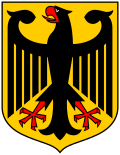Symbols
| Symbol | Image | Notes | |
|---|---|---|---|
| Flag | Flag of Germany |  | [2] |
| Coat of arms | Coat of arms of Germany |  | [2] |
| National anthem | Deutschlandlied |  | [2] |
| Majestic mark (Military) | Iron cross |  | [2] |
| National tree | Oak |  | [2] |
| German reunification symbol | Brandenburg Gate |  | [2] |
